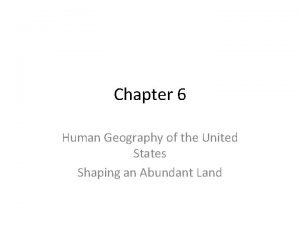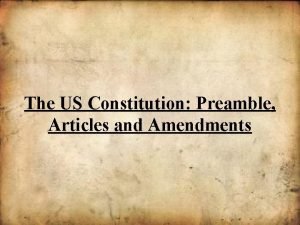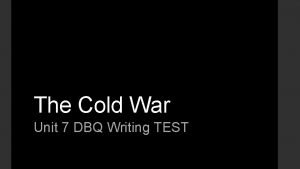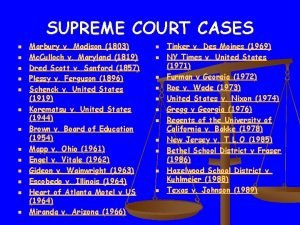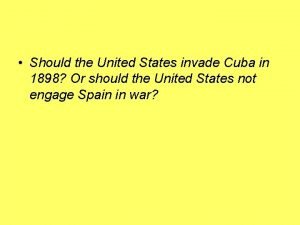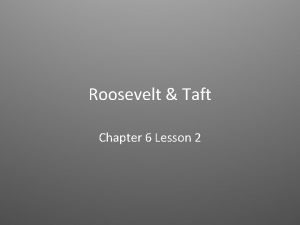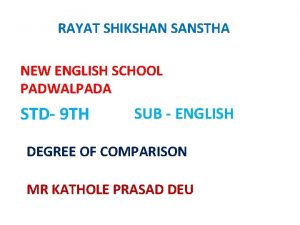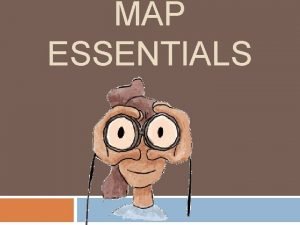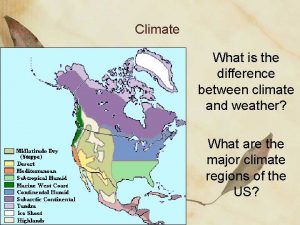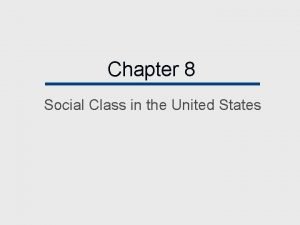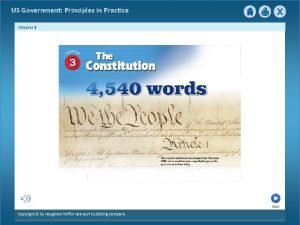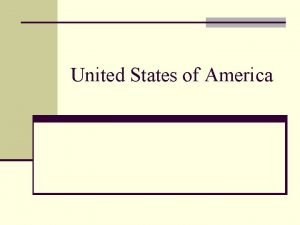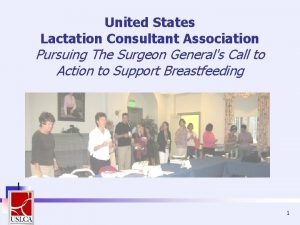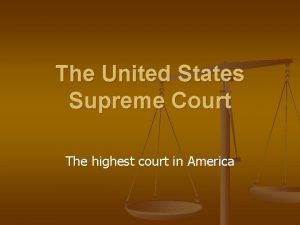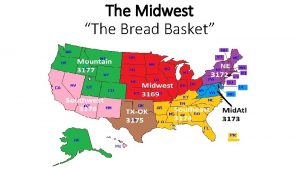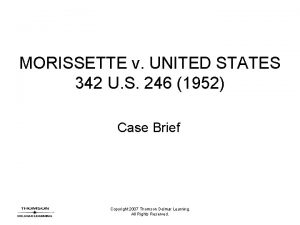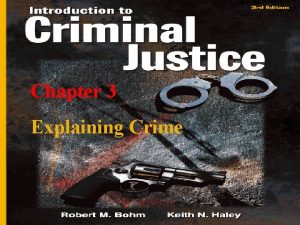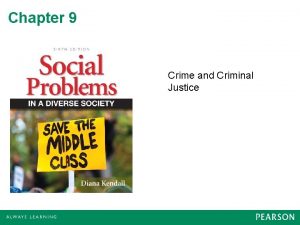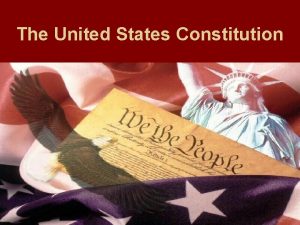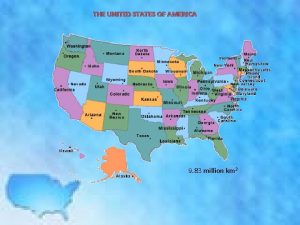Crime Justice In the United States Chapter One










































- Slides: 42

Crime & Justice In the United States Chapter One Introduction to Criminal Justice, Bohm & Haley

Article Criminal Justice Logjam • As Budgets Shrink, Cities See an Impact on Criminal Justice (Jun 7, 2003) • Criminal Justice Failure (Aug 6, 2002) • Britain Plans Criminal Justice Changes to Favor the Victims (Jul 18, 2002) Find more related articles by selecting from the following topics: Criminology Social Sciences Track a subject by e-mail o the Editor: It is disconcerting that the number of Americans under control of the criminal justice system - in prison, on probation or on parole - has risen once again, this year approaching nearly seven million ("U. S. 'Correctional Population' Hits New High, " news article, July 26). Taxpayers spend more than $50 billion a year to incarcerate more than two million people, making America the world's No. 1 jailer. Yet the Bureau of Justice Statistics shows that two-thirds of inmates are back behind bars within three years of release. A better approach would be to lock up fewer people for shorter periods of time and use the cost savings to bolster academic, vocational and substance abuse programs behind bars. That way, ex-offenders will have the tools they need to lead law-abiding lives on the outside. Jennifer R. Wynn Adjunct Professor John Jay College of Criminal Justice Brooklyn, July 26, 2004

Objectives Identify institutions of social control and explain what makes criminal justice an institution of social control. 2. Summarize how the criminal justice system responds to crime. 3. Explain why criminal justice in the United States is sometimes considered a nonsystem. 4. Point out the major differences between Packer’s crime control and due process models. 1.

Objectives Describe the costs of criminal justice in the United States and compare those costs among federal, state, and local governments. 6. Explain how myths about crime and criminal justice affect the criminal justice system. 7. Describe how the type of crime presented by the media compares with crime routinely committed. 5.

Institutions of Social Control n An institution of social control is: An organization that persuades people, through subtle and not-so-subtle means to abide by the dominant values of society. P. 8

Institutions of Social Control n Examples: Organized Religion Laws Family Schools News

Institutions of Social Control n Criminal Justice System is an institution of social control, but differs from others in two important ways: 1. Concerned only with behavior defined as criminal (limited behaviors), 2. It is “society’s last line of defense” against people who refuse to abide by dominant social values. Society turns to criminal justice “when all else fails”.

Criminal Justice: The System n Criminal justice in the US is administered by a loose confederation of more than 50, 000 agencies, federal, state and local governments. n This confederation is referred to as the “criminal justice system” p. 8

Criminal Justice System

Criminal Justice: The System n Jurisdiction: A politically defined geographical area (where the specific CJS entity has authority)

Criminal Justice: The System An Overview n WARNING: The following is a brief overview of a typical criminal justice system. (It is often more complicated than what is described in the text) n More detailed information will be covered later in the course. n Refer to Figure 1. 1 in your text, pp. 10 -11

Moves Quickly Police Receive a criminal Report Arrest is made, booking, then warrant, (initial appearance) GA- Juvenile Services Take Over

Misdemeanor No arraignment Unless jailed SUMMARY TRIAL p. 9

Synopsis of CJS n Officer investigates then makes an ARREST. n Offender becomes a DEFENDANT, then a BOOKING report (GA, A&B), is completed listing charges and any personal property, etc. n Prosecutor then reviews the facts and decides whether to charge, or pursue prosecution, then completes a charging document.

Charging Document Four (three) types: A complaint – a document specifying that an offense has been committed. n Arrest Warrant – another form of charging document often obtained by officers/investigators. n An information – a document that outlines the formal charge against a suspect. n A grand jury indictment – a written accusation by a grand jury that a person has committed a crime. n n

Offense Level n Misdemeanor – (includes ordinance violations) less serious crime generally punishable by a fine or by incarceration in jail for not more than 1 year. n Felony – (does not include ordinance violations) serious offense punishable by confinement in prison for more than 1 year or by death. (May include fines)

Pretrial Stages n After charges have been filed, the defendant is brought before a judge to hear the formal charges against them and to hear their constitutional rights. This is an initial appearance. n Often, in several states, the defendant can enter a plea of guilty or not guilty at this stage. (Georgia)

Pretrial Stages In misdemeanor cases, the defendant will go to trial, or summary trial, (ordinance violations, traffic, etc. ). n In the case of a felony, a hearing is held to determine whether the defendant should be released or whethere is probable cause to hold the defendant for a preliminary hearing. Probable cause is: n A standard of proof that requires evidence sufficient to make a reasonable person believe that, more likely than not, the proposed action is justified.

Pretrial Stages n If defendant is to be held, judge finds sufficient probable cause (evidence), then the judge may set bail (bond). Bail is usually a monetary guarantee deposited with the court to ensure that suspects or defendants will appear at a later stage in the criminal justice process.

Pretrial Stages n A primary purpose of the grand jury is to determine whethere is probable cause to believe that the accused committed the crime with which the prosecutor has charged him/her with. A grand jury is: A group of citizens who meet in closed sessions for a specified period to investigate charges coming from preliminary hearings and to fulfill other responsibilities. Defendant does not appear at Grand Jury hearings.

Pretrial Stages Defendants are then go to arraignment where they are allowed to plea. n At this stage, a majority of cases are handled through an arrangement called plea bargaining. P. 13 n The practice whereby a specific sentence is imposed if the accused pleads guilty to an agreed-upon charge or charges instead of going to trial.

Pretrial Stages – 10 percent of criminal cases go to trial. – 5 percent of criminal cases are decided in a bench trial. – 5 percent of criminal cases are decided in a jury trial. – 90 percent of cases are disposed of through plea bargaining.

Trial Stage n If found NOT GUILTY, defendant is released. If found guilty, they are sentenced by a judge, and in some cases by the jury.

Corrections n There 5 types of punishment used in the US: – Fines, – Probation, – Intermediate punishments, – Imprisonment, – Death

Corrections n Parole – defendant may be eligible after serving a portion of their sentence. Parole is: The conditional release of prisoners before they have served their full sentences.

Criminal Justice: The Non-System n Non-System because: Criminal Justice system is a loose confederation of many independent agencies. I. e. municipal courts, state courts, federal courts; local, state, federal law enforcement; 1.

Criminal Justice: The Non-System 2. As a “smoothly operating set of arrangements and institutions directed toward the achievement of common goals”, criminal justice system is NOT. Often there are competing goals, objectives, overlaps in jurisdiction, politically directed emphasis, i. e. drunk driving.

Packer’s Two Models of Criminal Justice

Two Models of Criminal Justice n Due Process Model p. 18 – “Obstacle Justice” – Doctrine of legal guilt – not guilty unless factual guilt is determined in a procedurally regular fashion. (Tends to Protect suspects) – Attempts to overcome issues of intelligence of suspect, financial resources for representation.

Two Models of Criminal Justice n Crime Control Model p. 17 – “assembly-line justice” controlling criminal behavior is the most important function of criminal justice. – Efficient process resulting in quick closure, – “Presumption of guilt”

Due Process vs. Crime Control n Since the mid-1970 s the crime control model has dominated the practice of criminal and juvenile justice in the United States. n But elements of the due process model remain evident in the process of justice. n How long this present trend will continue is anybody’s guess.

CJS Models: Know the Difference? Criminal Justice Logjam • As Budgets Shrink, Cities See an Impact on Criminal Justice (Jun 7, 2003) • Criminal Justice Failure (Aug 6, 2002) • Britain Plans Criminal Justice Changes to Favor the Victims (Jul 18, 2002) Find more related articles by selecting from the following topics: Criminology Social Sciences Track a subject by e-mail o the Editor: It is disconcerting that the number of Americans under control of the criminal justice system - in prison, on probation or on parole - has risen once again, this year approaching nearly seven million ("U. S. 'Correctional Population' Hits New High, " news article, July 26). Taxpayers spend more than $50 billion a year to incarcerate more than two million people, making America the world's No. 1 jailer. Yet the Bureau of Justice Statistics shows that two-thirds of inmates are back behind bars within three years of release. A better approach would be to lock up fewer people for shorter periods of time and use the cost savings to bolster academic, vocational and substance abuse programs behind bars. That way, ex-offenders will have the tools they need to lead law-abiding lives on the outside. Jennifer R. Wynn Adjunct Professor John Jay College of Criminal Justice Brooklyn, July 26, 2004

Costs of Criminal Justice Each year in the United States an enormous amount of money is spent on criminal justice. n In 1999, local, state, and federal governments spent a total of $146 billion in direct expenditures for the civil and criminal justice systems. n That represents approximately $525 for every resident of the United Sates. n See Table 1. 2, p. 20. n

Costs of Criminal Justice Of all government expenditures, Criminal Justice only accounts for 8%. n Police Protection – 70% local government n Corrections – States 63% n Judicial/Legal Services – 35% States n

Myths about Criminal Justice n Our text concentrates on dispelling myths about the criminal justice system. n What myths have we dispelled? n Government budget allocations for CJS accounts for a bulk of all expenditures?

Media & CJS ee L n h o J o v l Ma & d O. a J. m Si m a m h ps u M on n , M h o ar J th Geo a. S rgia te wa -M rt urd er o f. G ran dpa ren ts

Media & CJS n The sensational crimes reported by the media do not provide a very accurate picture of the crimes typically committed nor do they accurately depict the kinds of crime to which police respond on a daily basis.

Media & CJS: Discussion n What did you learn from your project assignments? n Do you feel that the crime related stories provided enough information for you to determine guilt or innocence? n Does the news media provide clear, and accurate information?

Media & CJS n The media does not accurately reflect the typical calls that police respond to, nor does television coverage of trials, etc. , accurately reflect the courts, (90% plea bargain) n Does this media attention “help” or “hurt” the criminal justice system operation?

Review n Institution of social control – what And know some examples. is it? – How does CJS differ from other institutions of social control (2 reasons) n Know the Models of Criminal Justice – Which one is the predominant today? – Key differences

Review n Media & CJS n Corrections – 5 methods n Costs of Criminal Justice n n – Who pays most for police? – Who pays most for corrections? Charging Documents Have a general knowledge of the CJS “Process”, chart in text, pp. 10 -11.

Next Week n Review the online materials related to Uniform Crime Reports, n View the Department of Justice, FBI, Uniform Crime Reports web-site.
 Chapter 2 free enterprise in the united states answer key
Chapter 2 free enterprise in the united states answer key Chapter 6 human geography of the united states
Chapter 6 human geography of the united states What states are west of the mississippi river
What states are west of the mississippi river Was the united states on the axis powers or allied powers?
Was the united states on the axis powers or allied powers? Unit 2: the united states and canada worksheet answers
Unit 2: the united states and canada worksheet answers Slave state
Slave state Us pro soccer teams
Us pro soccer teams United states v nixon outcome
United states v nixon outcome United states student association
United states student association The united states ought to provide a universal basic income
The united states ought to provide a universal basic income Preamble of us constitution
Preamble of us constitution The united states in the caribbean 1776-1985
The united states in the caribbean 1776-1985 Physical features of the southeast region
Physical features of the southeast region Expansion of the united states of america 1607 to 1853 map
Expansion of the united states of america 1607 to 1853 map How did nicholas novikov describe the united states
How did nicholas novikov describe the united states Oregon country previous owner
Oregon country previous owner What is the message
What is the message Heart of atlanta motel v. united states
Heart of atlanta motel v. united states Why did the united states invade cuba in 1898?
Why did the united states invade cuba in 1898? Lesson 2 roosevelt and taft
Lesson 2 roosevelt and taft Nnn
Nnn 7 regions of the united states
7 regions of the united states The united states is the greatest buyer positive degree
The united states is the greatest buyer positive degree United states and canada physical map
United states and canada physical map Physical geography of the usa
Physical geography of the usa 0 degree latitude
0 degree latitude Fifty united states
Fifty united states Perceptual regions of the united states
Perceptual regions of the united states United states circus clown (1898-1979)
United states circus clown (1898-1979) Subtropical united states
Subtropical united states Consequences of social class
Consequences of social class Physical geography of the united states
Physical geography of the united states Ibn-tamas v. united states
Ibn-tamas v. united states What is the theme of when mr pirzada came to dine
What is the theme of when mr pirzada came to dine United states government: principles in practice solutions
United states government: principles in practice solutions Geographical position usa
Geographical position usa United states lactation consultant association
United states lactation consultant association Plessy v ferguson summary
Plessy v ferguson summary Mississippi physical features
Mississippi physical features Bread basket physical features
Bread basket physical features Immigration to the united states
Immigration to the united states United states v. cruikshank apush
United states v. cruikshank apush Morissette v united states case brief
Morissette v united states case brief

